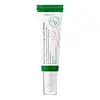What's inside
What's inside
 Key Ingredients
Key Ingredients

 Benefits
Benefits

 Concerns
Concerns

No concerns
 Ingredients Side-by-side
Ingredients Side-by-side

Snail Secretion Filtrate 83%
Skin ConditioningPropanediol
SolventGlycerin
HumectantNiacinamide
Smoothing1,2-Hexanediol
Skin ConditioningPanthenol
Skin ConditioningBetaine
HumectantSodium Hyaluronate
HumectantBeta-Glucan
Skin ConditioningAloe Barbadensis Leaf Extract
EmollientDipotassium Glycyrrhizate
HumectantAllantoin
Skin ConditioningAdenosine
Skin ConditioningHamamelis Virginiana Leaf Extract
Skin ConditioningRosmarinus Officinalis Extract
AntimicrobialEucalyptus Globulus Leaf Extract
PerfumingThymus Vulgaris Extract
PerfumingAspalathus Linearis Extract
Skin ConditioningSodium Polyacrylate
AbsorbentSnail Secretion Filtrate 83%, Propanediol, Glycerin, Niacinamide, 1,2-Hexanediol, Panthenol, Betaine, Sodium Hyaluronate, Beta-Glucan, Aloe Barbadensis Leaf Extract, Dipotassium Glycyrrhizate, Allantoin, Adenosine, Hamamelis Virginiana Leaf Extract, Rosmarinus Officinalis Extract, Eucalyptus Globulus Leaf Extract, Thymus Vulgaris Extract, Aspalathus Linearis Extract, Sodium Polyacrylate
Water
Skin ConditioningGlycerin
HumectantNiacinamide
SmoothingSodium Hyaluronate
HumectantPropanediol
SolventErythritol
HumectantButylene Glycol
HumectantSqualane
EmollientOryza Sativa Bran Extract
Skin ConditioningCalendula Officinalis Flower Extract
MaskingCarica Papaya Fruit Extract
Skin ConditioningHippophae Rhamnoides Fruit Extract
Skin ConditioningMalpighia Glabra Fruit Extract
Skin ConditioningPolyglyceryl-10 Laurate
Skin ConditioningChlorphenesin
AntimicrobialArginine
MaskingEthylhexylglycerin
Skin ConditioningCarbomer
Emulsion StabilisingGlutathione
1,2-Hexanediol
Skin ConditioningHydroxypropyl Cyclodextrin
MaskingDisodium EDTA
Hydroxyethylcellulose
Emulsion StabilisingAllantoin
Skin ConditioningRosmarinus Officinalis Leaf Oil
MaskingWater, Glycerin, Niacinamide, Sodium Hyaluronate, Propanediol, Erythritol, Butylene Glycol, Squalane, Oryza Sativa Bran Extract, Calendula Officinalis Flower Extract, Carica Papaya Fruit Extract, Hippophae Rhamnoides Fruit Extract, Malpighia Glabra Fruit Extract, Polyglyceryl-10 Laurate, Chlorphenesin, Arginine, Ethylhexylglycerin, Carbomer, Glutathione, 1,2-Hexanediol, Hydroxypropyl Cyclodextrin, Disodium EDTA, Hydroxyethylcellulose, Allantoin, Rosmarinus Officinalis Leaf Oil
 Reviews
Reviews

Ingredients Explained
These ingredients are found in both products.
Ingredients higher up in an ingredient list are typically present in a larger amount.
1,2-Hexanediol is a synthetic liquid and another multi-functional powerhouse.
It is a:
- Humectant, drawing moisture into the skin
- Emollient, helping to soften skin
- Solvent, dispersing and stabilizing formulas
- Preservative booster, enhancing the antimicrobial activity of other preservatives
Allantoin is a soothing ingredient known for its protective and moisturizingg properties. Because of this, it is often added to products with strong active ingredients.
Studies show higher concentrations of this ingredient can promote wound healing.
Though it can be derived from the comfrey plant, allantoin is produced synthetically for cosmetic products to ensure purity.
Learn more about AllantoinGlycerin is already naturally found in your skin. It helps moisturize and protect your skin.
A study from 2016 found glycerin to be more effective as a humectant than AHAs and hyaluronic acid.
As a humectant, it helps the skin stay hydrated by pulling moisture to your skin. The low molecular weight of glycerin allows it to pull moisture into the deeper layers of your skin.
Hydrated skin improves your skin barrier; Your skin barrier helps protect against irritants and bacteria.
Glycerin has also been found to have antimicrobial and antiviral properties. Due to these properties, glycerin is often used in wound and burn treatments.
In cosmetics, glycerin is usually derived from plants such as soybean or palm. However, it can also be sourced from animals, such as tallow or animal fat.
This ingredient is organic, colorless, odorless, and non-toxic.
Glycerin is the name for this ingredient in American English. British English uses Glycerol/Glycerine.
Learn more about GlycerinNiacinamide is a multitasking form of vitamin B3 that strengthens the skin barrier, reduces pores and dark spots, regulates oil, and improves signs of aging.
And the best part? It's gentle and well-tolerated by most skin types, including sensitive and reactive skin.
You might have heard of "niacin flush", or the reddening of skin that causes itchiness. Niacinamide has not been found to cause this.
In very rare cases, some individuals may not be able to tolerate niacinamide at all or experience an allergic reaction to it.
If you are experiencing flaking, irritation, and dryness with this ingredient, be sure to double check all your products as this ingredient can be found in all categories of skincare.
When incorporating niacinamide into your routine, look out for concentration amounts. Typically, 5% niacinamide provides benefits such as fading dark spots. However, if you have sensitive skin, it is better to begin with a smaller concentration.
When you apply niacinamide to your skin, your body converts it into nicotinamide adenine dinucleotide (NAD). NAD is an essential coenzyme that is already found in your cells as "fuel" and powers countless biological processes.
In your skin, NAD helps repair cell damage, produce new healthy cells, support collagen production, strengthen the skin barrier, and fight environmental stressors (like UV and pollution).
Our natural NAD levels start to decline with age, leading to slower skin repair, visible aging, and a weaker skin barrier. By providing your skin niacinamide, you're recharging your skin's NAD levels. This leads to stronger, healthier, and younger looking skin.
Another name for vitamin B3 is nicotinamide. This vitamin is water-soluble and our bodies don't store it. We obtain Vitamin B3 from either food or skincare. Meat, fish, wheat, yeast, and leafy greens contain vitamin B3.
The type of niacinamide used in skincare is synthetically created.
Learn more about NiacinamidePropanediol is an all-star ingredient. It softens, hydrates, and smooths the skin.
It’s often used to:
Propanediol is not likely to cause sensitivity and considered safe to use. It is derived from corn or petroleum with a clear color and no scent.
Learn more about PropanediolSodium Hyaluronate is hyaluronic acid's salt form. It is commonly derived from the sodium salt of hyaluronic acid.
Like hyaluronic acid, it is great at holding water and acts as a humectant. This makes it a great skin hydrating ingredient.
Sodium Hyaluronate is naturally occurring in our bodies and is mostly found in eye fluid and joints.
These are some other common types of Hyaluronic Acid:
Learn more about Sodium Hyaluronate